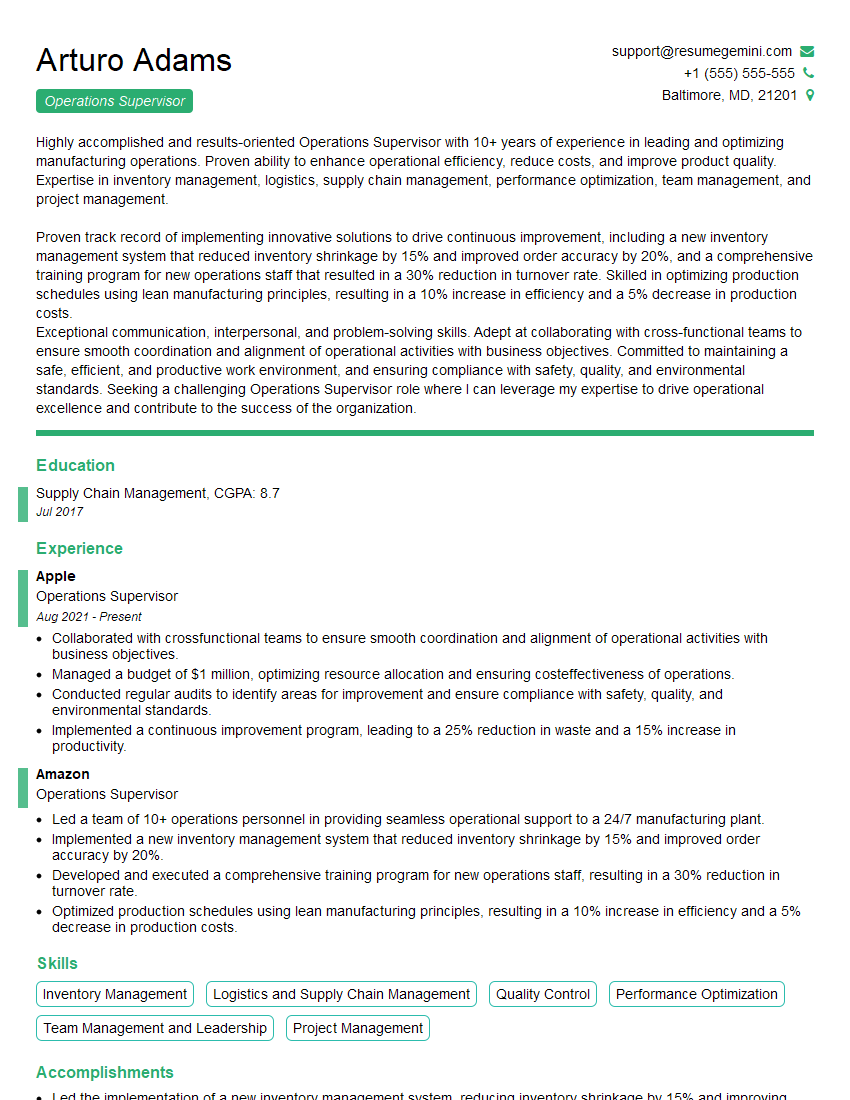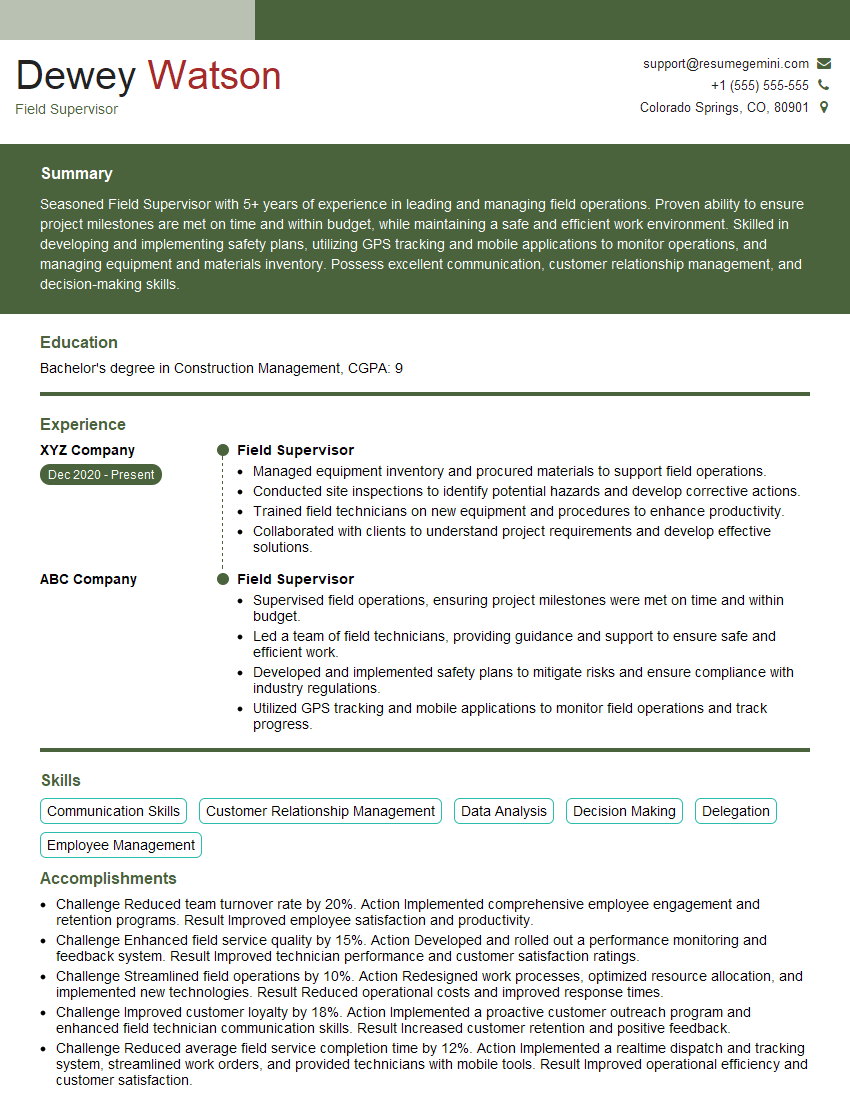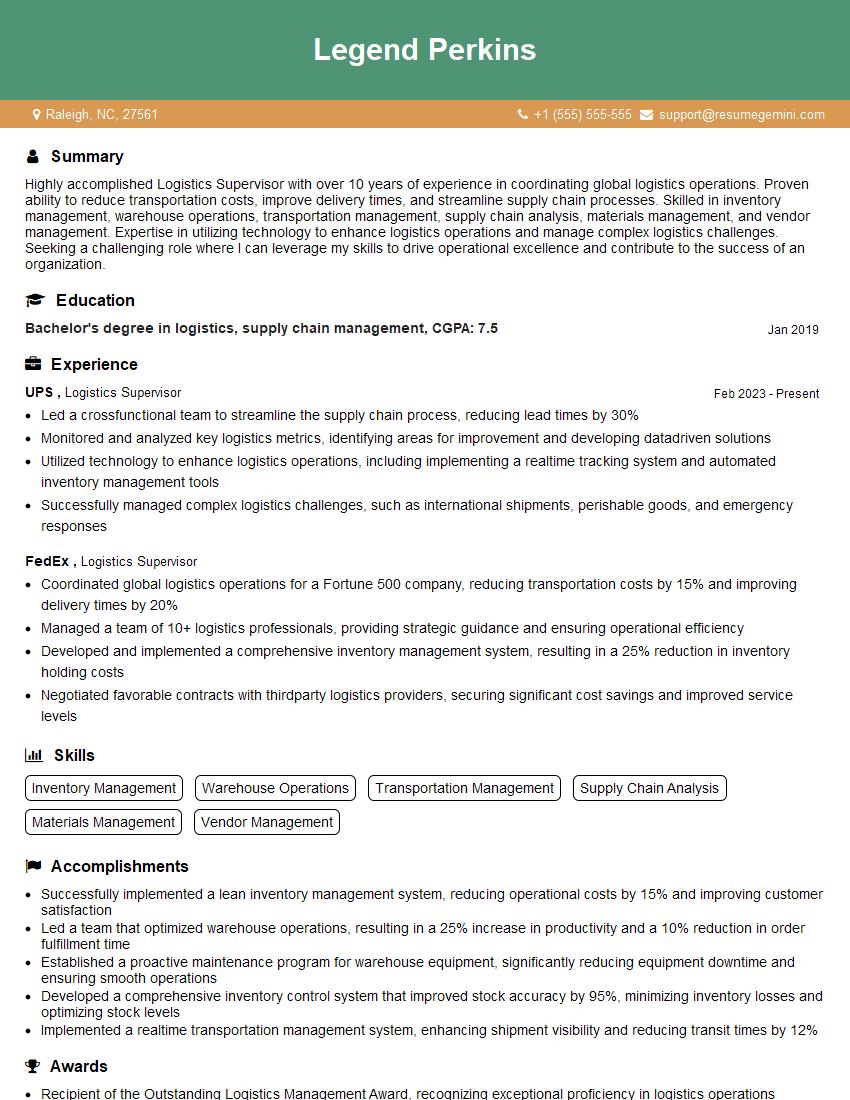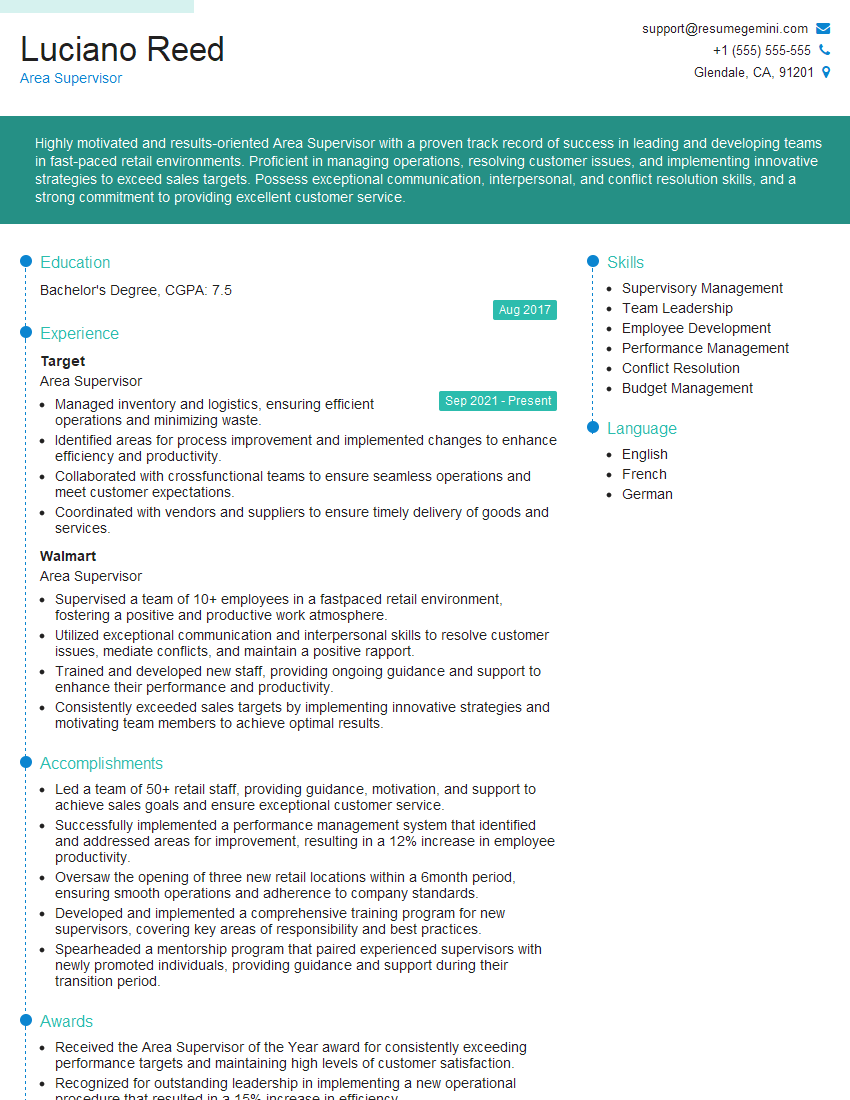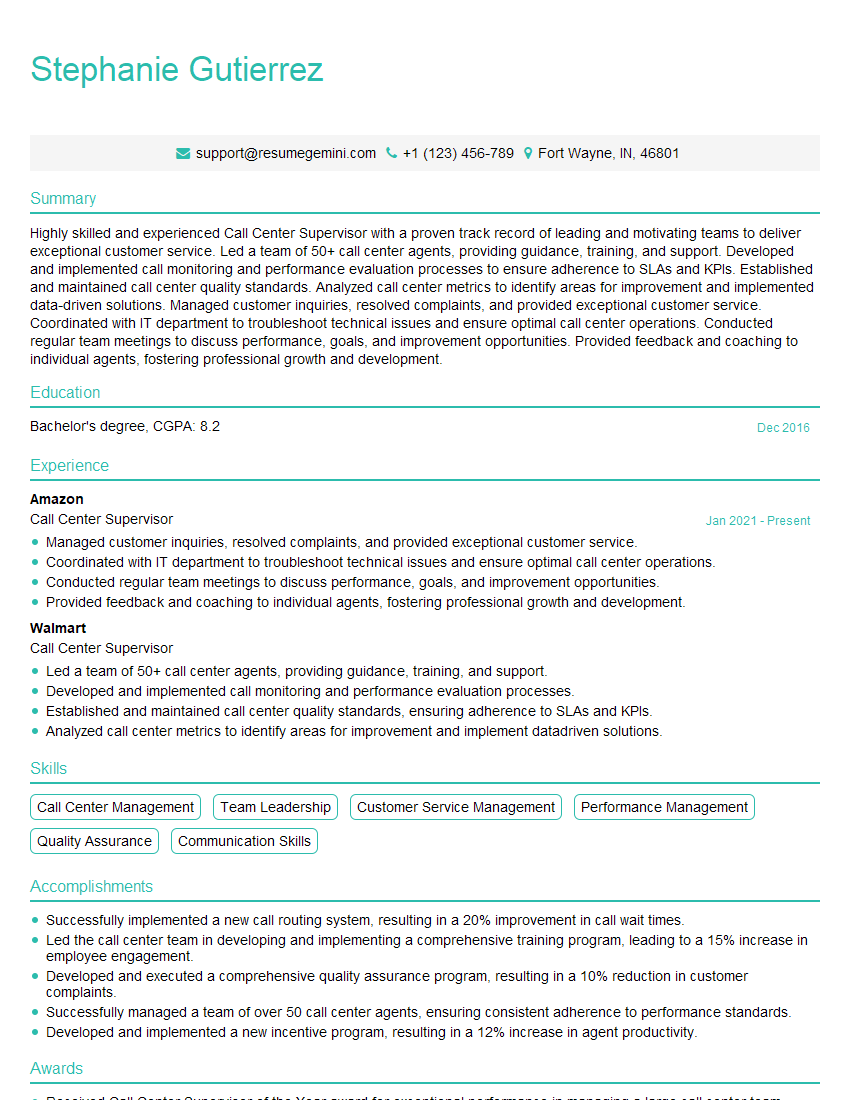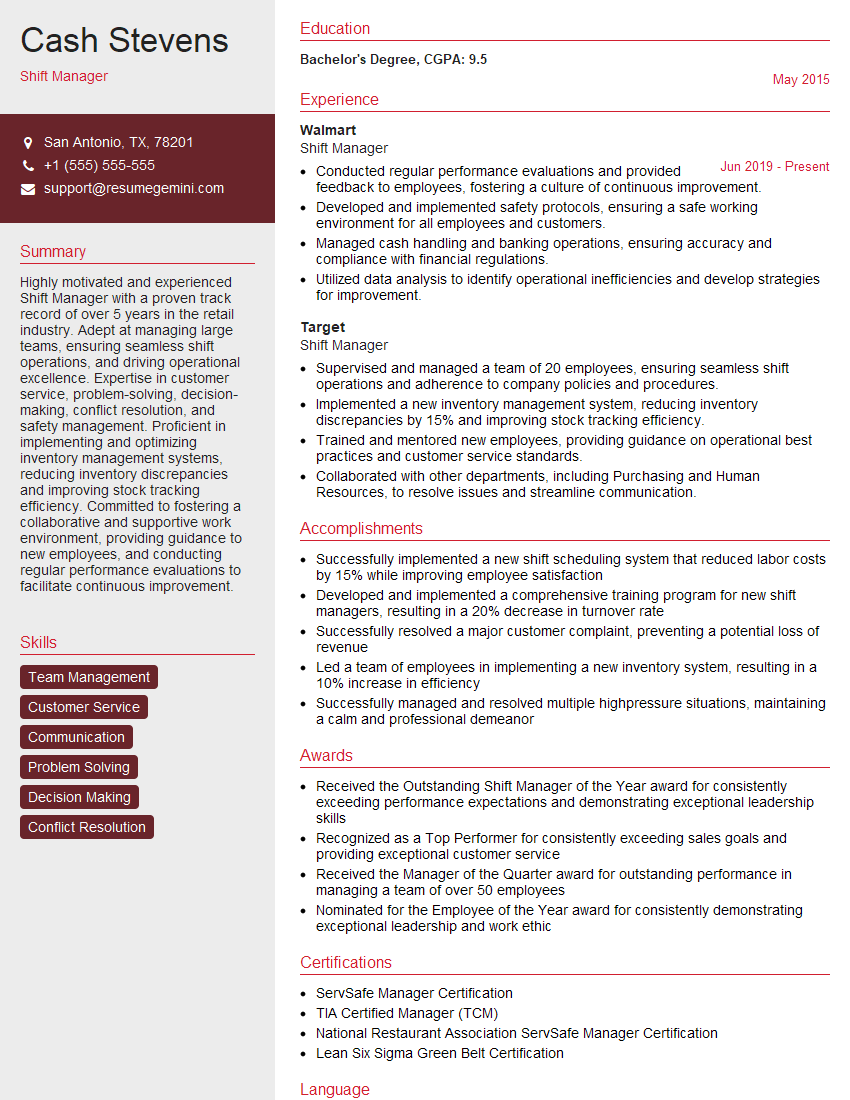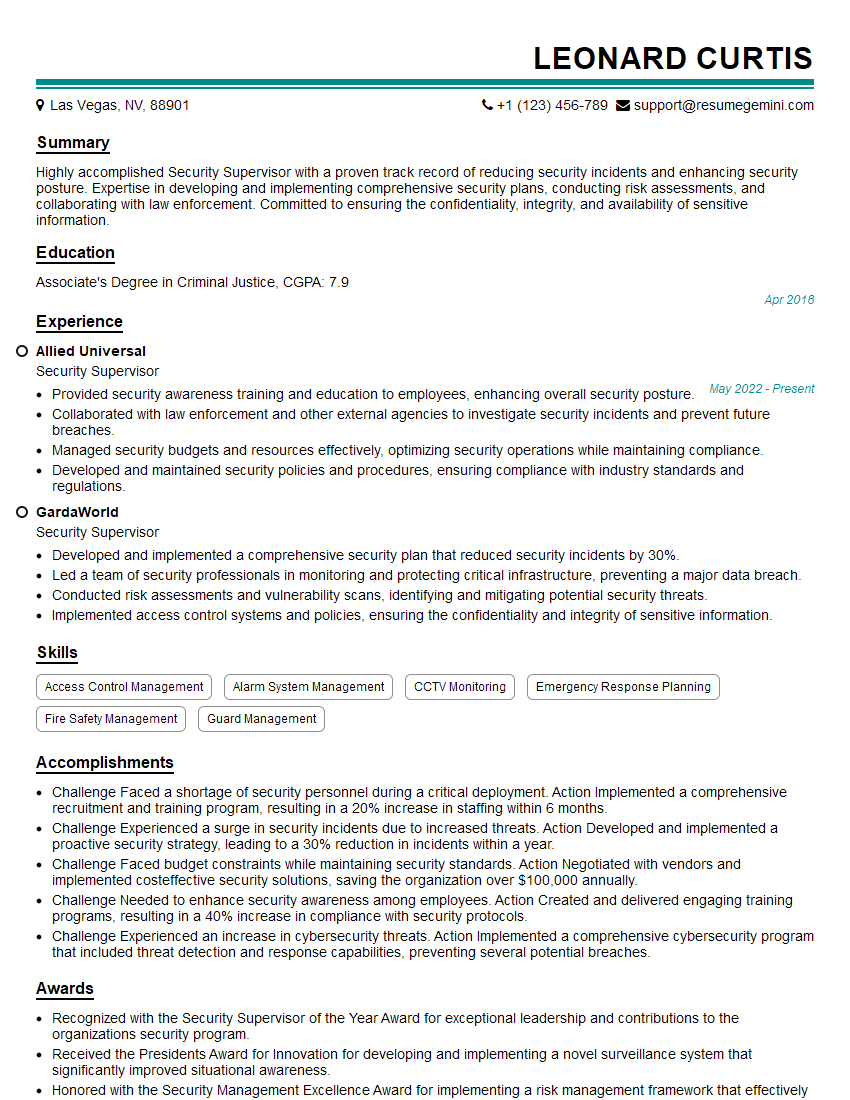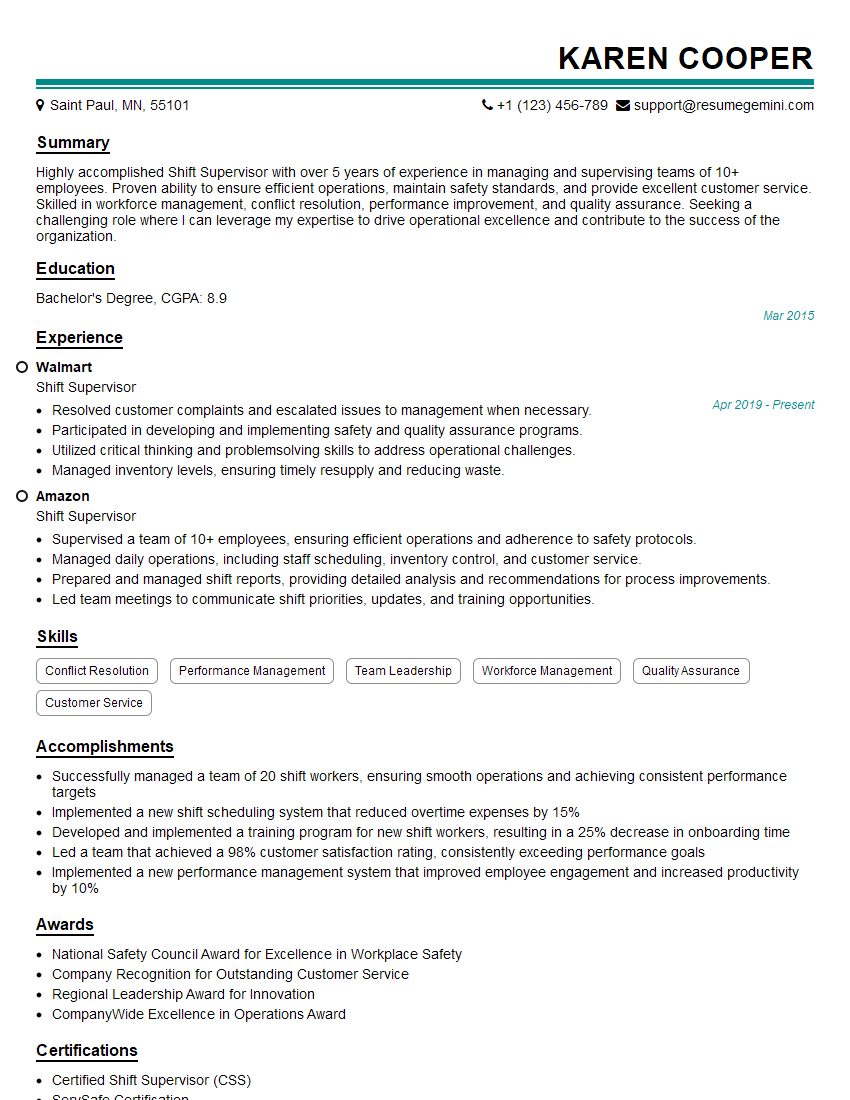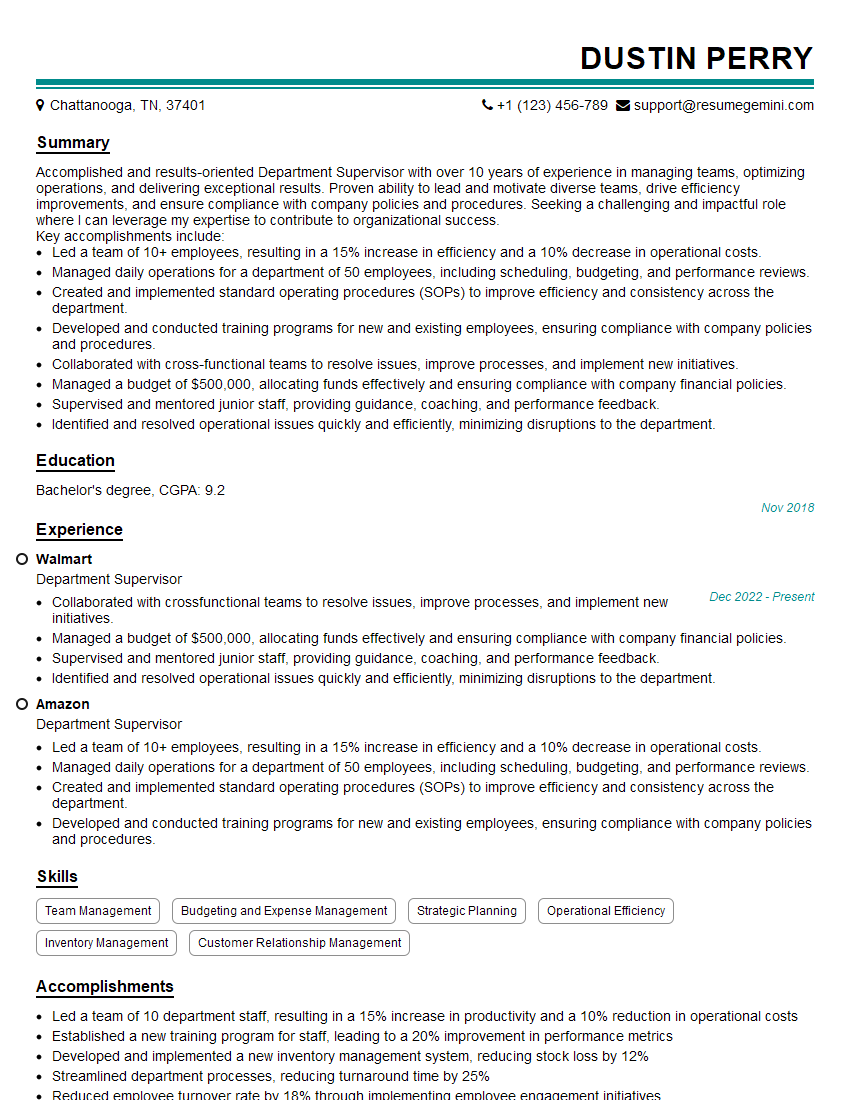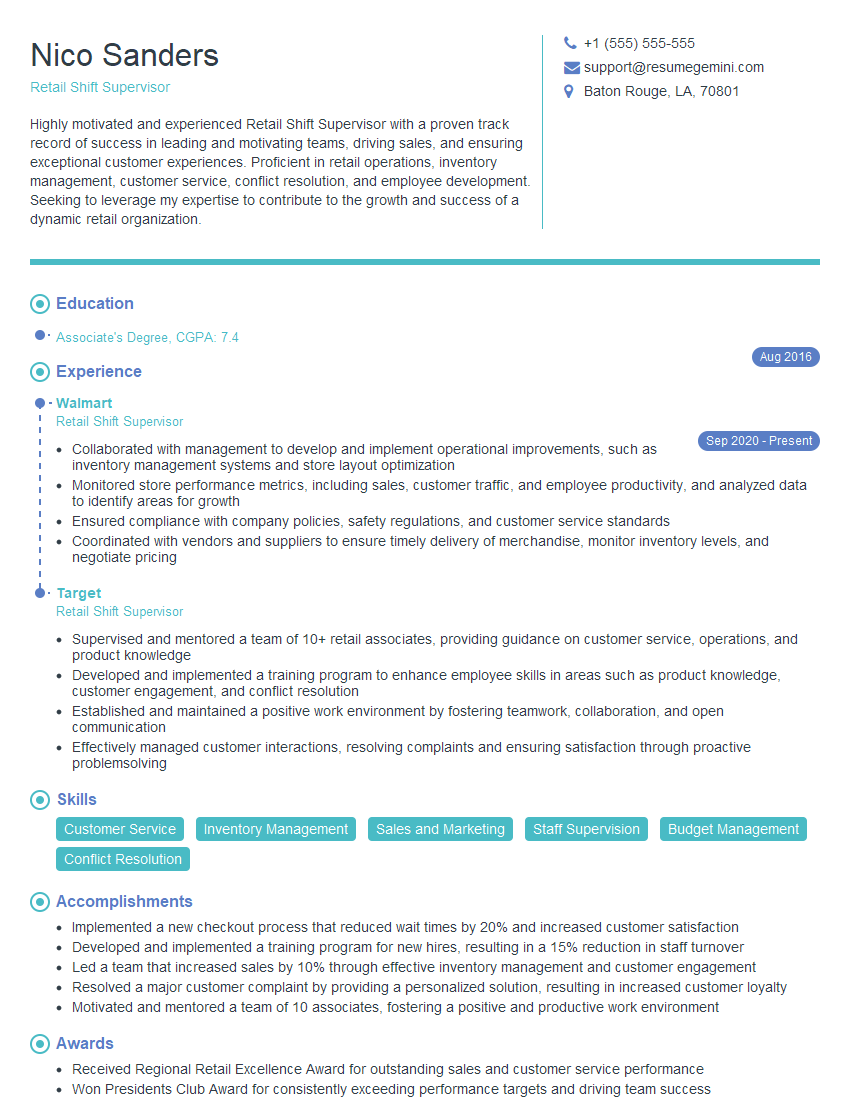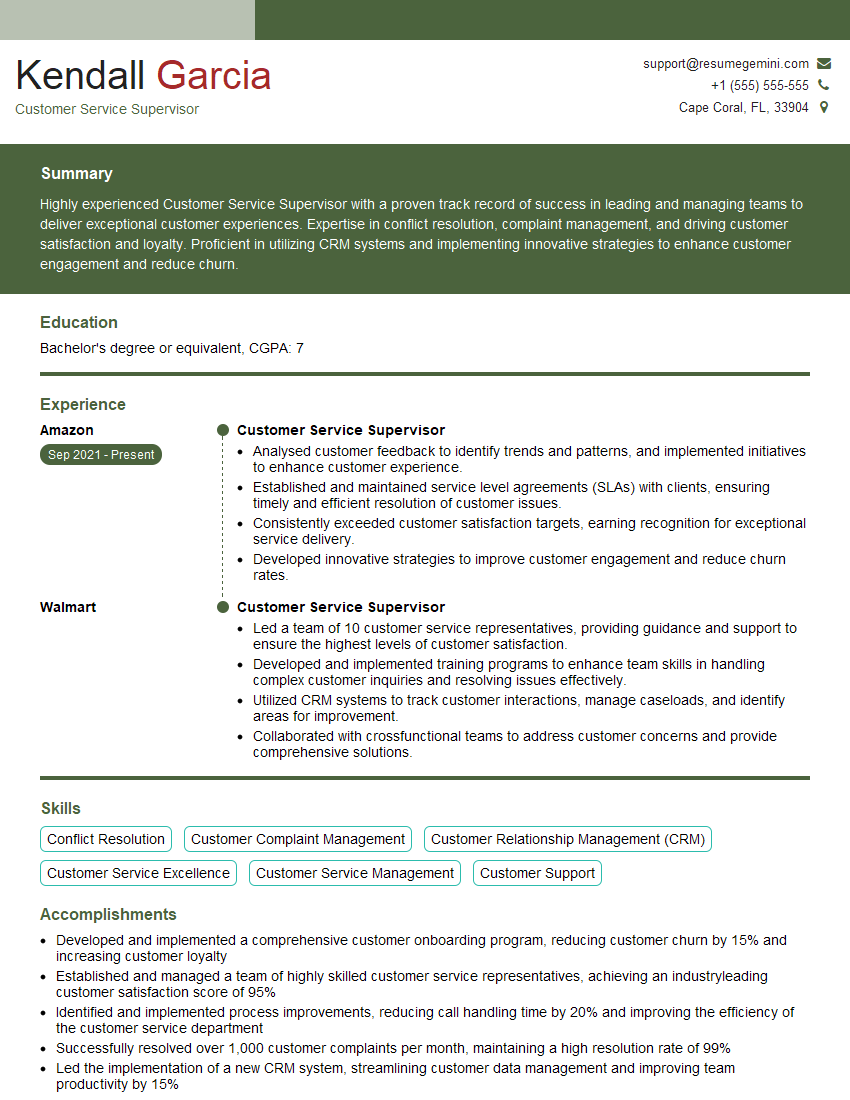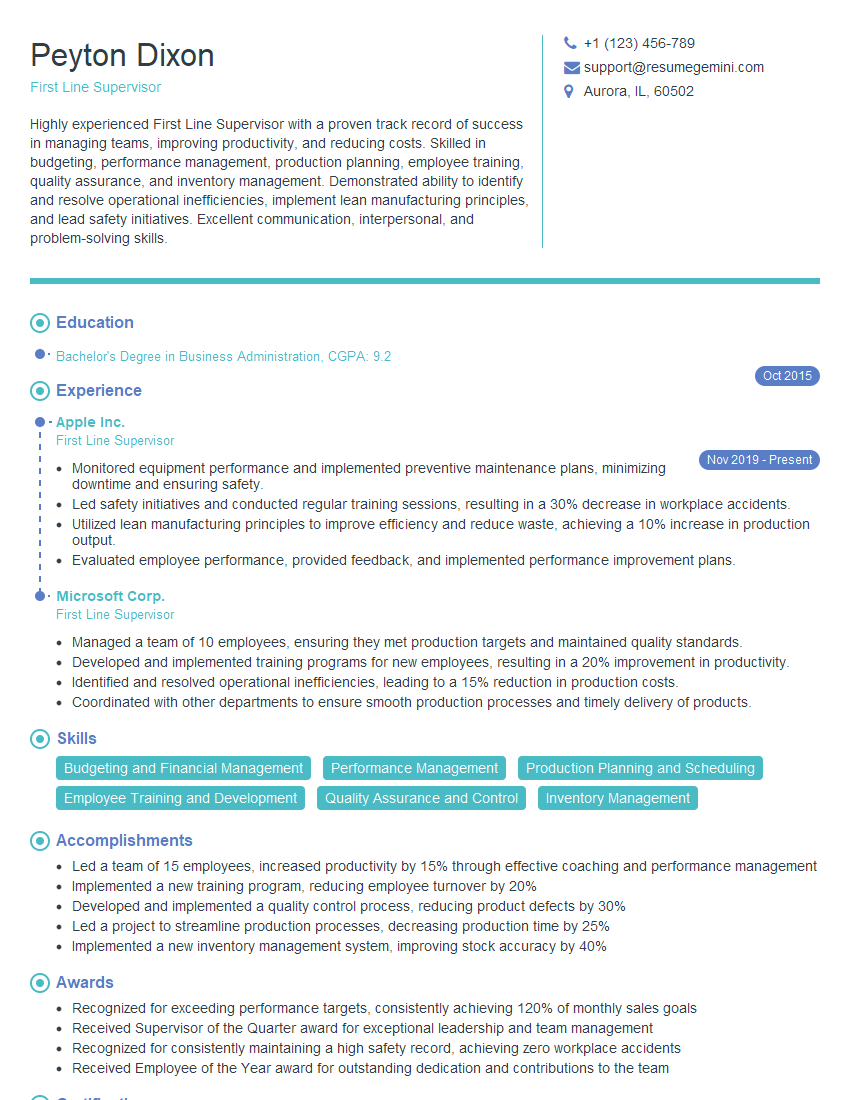The thought of an interview can be nerve-wracking, but the right preparation can make all the difference. Explore this comprehensive guide to Shift Supervision and Leadership interview questions and gain the confidence you need to showcase your abilities and secure the role.
Questions Asked in Shift Supervision and Leadership Interview
Q 1. Describe your experience in managing a team during a peak workload period.
Managing a team during peak workload requires a proactive and organized approach. It’s not just about pushing harder, but about optimizing resources and maintaining team morale. My strategy involves several key steps: Firstly, I conduct a thorough assessment of the workload, identifying bottlenecks and critical tasks. This helps prioritize efforts. Then, I clearly communicate expectations and the overall goals to the team. Transparency is crucial during high-pressure situations. Next, I delegate tasks based on individual skills and strengths, ensuring everyone has a clear understanding of their responsibilities and deadlines. I also actively monitor progress, offering support and guidance where needed. Finally, I implement strategies to mitigate stress, such as flexible breaks and open communication channels. During a particularly busy holiday season at a retail store, I used this approach. I identified the gift-wrapping station as a bottleneck. By adding extra staff and streamlining the process, we reduced wait times and boosted customer satisfaction, ultimately leading to higher sales and better team morale despite the pressure.
Q 2. How do you handle employee conflicts within your shift?
Handling employee conflicts requires a fair and impartial approach. My strategy focuses on timely intervention and open communication. I encourage employees to voice their concerns in a respectful manner, providing a safe space for dialogue. I actively listen to understand each perspective before mediating the situation. Depending on the nature of the conflict, I may facilitate a direct conversation between the involved parties or, in more serious cases, involve HR. The goal is always to resolve the conflict fairly, ensuring a positive working environment for everyone. For example, I once had a disagreement between two team members regarding workflow assignments. By facilitating a calm discussion and clarifying the roles and responsibilities, I resolved the issue and strengthened their working relationship.
Q 3. Explain your approach to delegating tasks and responsibilities.
My approach to delegation is based on matching tasks with individual skills and potential. I consider each team member’s strengths, weaknesses, and workload before assigning tasks. This requires knowing my team well – their capabilities, experience level, and career aspirations. I ensure that tasks are appropriately challenging, providing opportunities for growth and development. Clear instructions, including deadlines and expected outcomes, are crucial. I also offer support and feedback throughout the process, providing guidance and addressing any challenges that may arise. Think of it like a coach assigning roles to players in a team – you want to put people where they’ll excel and contribute most effectively. For instance, a new team member might start with simpler tasks to build confidence and proficiency before taking on more complex projects.
Q 4. What strategies do you use to improve team morale and productivity?
Improving team morale and productivity is a continuous process that requires attention to both individual and team dynamics. My strategies include open communication, creating a positive work environment, and acknowledging individual contributions. Regular team meetings provide opportunities for feedback and problem-solving. Celebrating successes, big or small, boosts morale and creates a sense of accomplishment. I also encourage team-building activities to foster collaboration and camaraderie. Additionally, providing opportunities for professional development demonstrates investment in the team’s growth, which can significantly improve motivation and performance. For example, during a challenging project, we implemented a ‘Kudos Board’ where team members could publicly recognize each other’s efforts, significantly boosting morale and collaboration.
Q 5. How do you ensure employee adherence to safety regulations?
Ensuring employee adherence to safety regulations is paramount. This involves a multi-pronged approach. Firstly, I provide comprehensive safety training to all team members, covering relevant regulations and procedures. Regular refresher courses are conducted to reinforce learning and address any changes in regulations. Secondly, I create a safety-conscious culture within the team, emphasizing personal responsibility and accountability. This includes regular safety audits and inspections to identify potential hazards and address safety concerns proactively. Finally, I actively communicate with team members, encouraging them to report any safety concerns or incidents without fear of reprisal. Implementing a clear reporting system and investigating incidents thoroughly is key to preventing future occurrences. For instance, we instituted a ‘Stop Work Authority’ program, empowering any team member to halt operations if they observe a safety violation.
Q 6. Describe a time you had to make a difficult decision under pressure.
During a critical equipment malfunction, we faced a significant production shutdown. The pressure was immense as we had a tight deadline. I had to decide whether to attempt a quick, potentially risky repair or call in specialist technicians, which would significantly delay production. After assessing the situation, considering the expertise of my team and the potential risks of each option, I chose to bring in the specialists. While this delayed production, it ultimately prevented further damage and potential injuries. This decision highlighted the importance of weighing short-term pressures against long-term consequences, focusing on safety and preventing potentially greater losses. This experience taught me the importance of objective analysis, even under extreme pressure.
Q 7. How do you identify and address performance issues among your team members?
Identifying and addressing performance issues requires a structured and supportive approach. I start by observing the individual’s performance, documenting specific instances where issues arise. Then, I schedule a private meeting with the employee to discuss my observations. The conversation focuses on specifics, providing constructive feedback and examples. I actively listen to their perspective, seeking to understand the root cause of the performance issues. Together, we develop a performance improvement plan with clear goals, timelines, and support mechanisms. Regular follow-up meetings monitor progress, providing ongoing guidance and adjustments to the plan as needed. If improvement is not achieved, progressive disciplinary measures may be necessary, always adhering to company policies. For example, if a team member consistently misses deadlines, I would work with them to identify the underlying cause, whether it’s lack of training, organizational issues, or personal challenges, and tailor support accordingly.
Q 8. What methods do you use to track key performance indicators (KPIs) within your shift?
Tracking KPIs is crucial for monitoring shift performance and identifying areas for improvement. My approach involves a multi-faceted strategy combining real-time monitoring with regular reporting.
Real-time dashboards: We utilize digital dashboards displaying key metrics like order fulfillment rates, error rates, customer satisfaction scores (if applicable), and productivity per employee. This allows for immediate identification of trends and potential issues.
Automated data collection: Wherever possible, we automate data collection through our systems. This minimizes manual data entry and ensures accuracy. For instance, our POS system directly feeds sales data into our KPI dashboard.
Regular reporting and analysis: At the end of each shift, a brief report summarizing key KPIs is generated. This report is then analyzed to identify trends and potential problems. We use this data to inform future scheduling and training initiatives.
Regular team meetings: We hold brief meetings to review the KPIs, discuss performance, and brainstorm solutions to improve metrics. This ensures transparency and team buy-in.
For example, if we notice a consistent dip in order fulfillment rates during the lunch rush, we can analyze the root cause (e.g., insufficient staffing, inefficient workflow) and implement solutions such as adjusting staffing levels or streamlining processes.
Q 9. How do you provide constructive feedback to your team?
Constructive feedback is about helping team members grow, not about criticism. I focus on the ‘sandwich’ method: positive feedback, constructive criticism, and more positive feedback.
Start with the positive: I always begin by acknowledging their strengths and successes. For example, ‘I really appreciate your proactive approach to handling the customer complaint earlier.’ This creates a receptive environment.
Provide specific, actionable feedback: Instead of saying ‘you’re slow,’ I might say ‘I noticed you spent a significant amount of time on task X. Could we discuss a more efficient workflow to shorten that time?’ This provides clear guidance.
Focus on behavior, not personality: I focus on observable behaviors and their impact. Instead of ‘you’re lazy,’ I’d say ‘I’ve noticed a decrease in your output recently. Is there anything I can do to help?’
End on a positive note: I always conclude with encouragement and reaffirm my confidence in their abilities. ‘I know you can improve, and I’m here to support you every step of the way.’
This approach ensures the feedback is received positively and leads to improvement. It’s all about fostering a growth mindset within the team.
Q 10. Describe your experience with shift scheduling and staff allocation.
Effective shift scheduling and staff allocation are critical for maintaining optimal productivity and employee morale. My experience involves a blend of forecasting, historical data analysis, and flexible scheduling.
Forecasting demand: I use historical data and predicted demand (e.g., expected customer volume, special events) to forecast staffing needs. This helps optimize staffing levels to meet customer needs while avoiding overstaffing.
Staff skillset matching: I carefully match employee skills and experience to the tasks required during each shift. This ensures tasks are completed efficiently and effectively.
Flexible scheduling: I embrace flexible scheduling options where feasible, considering employee availability and preferences while ensuring adequate coverage during peak times. This fosters employee satisfaction and reduces absenteeism.
Real-time adjustments: I continuously monitor staffing levels throughout the shift and make real-time adjustments as needed. If an unexpected surge in customers occurs, I can quickly re-allocate staff to meet demand.
For example, during a particularly busy holiday season, I analyzed past sales data to predict peak hours and proactively scheduled additional staff accordingly, which prevented long wait times and ensured a smooth operation.
Q 11. How do you ensure efficient communication among your team members?
Efficient communication is the backbone of a well-functioning team. I employ a multi-pronged approach to ensure clear and timely communication.
Regular briefings: At the start of each shift, I conduct a brief team meeting to discuss priorities, upcoming tasks, and potential challenges. This sets a clear direction.
Open communication channels: I encourage open communication through various channels like instant messaging, email, and direct conversations. This ensures everyone feels comfortable raising concerns or asking questions.
Visual aids: I often utilize visual aids like whiteboards or digital dashboards to communicate key information, making it easily accessible and understandable.
Regular feedback sessions: I regularly solicit feedback from team members to identify communication breakdowns and address any concerns.
For instance, during a product recall, I utilized a combination of instant messaging for immediate updates and email for detailed instructions, ensuring everyone was informed and able to act quickly and effectively.
Q 12. How do you handle unexpected absences or emergencies during your shift?
Unexpected absences or emergencies require a swift and effective response. My approach involves preemptive planning and efficient contingency strategies.
Maintaining a contact list: I maintain an up-to-date contact list of available employees who can fill in for absent colleagues.
Cross-training: I prioritize cross-training my team members so that they can handle multiple tasks. This ensures that if one person is absent, others can step in and maintain operations.
Prioritization: During emergencies, I prioritize tasks to ensure essential operations are maintained. Less critical tasks can be deferred until additional support is available.
Delegation: I delegate tasks efficiently to ensure workload is distributed fairly. This prevents burnout and maintains morale.
For example, when a team member called in sick unexpectedly, I was able to quickly reassign their tasks based on the cross-training we had done, minimizing disruption to the workflow.
Q 13. What is your experience with employee training and development?
Employee training and development is an ongoing process for me. I believe in a combination of formal training and on-the-job learning.
Structured training programs: I participate in designing and implementing structured training programs for new hires and ongoing development for existing employees. This ensures everyone has the necessary skills.
Mentorship: I foster a culture of mentorship where experienced employees guide and support newer colleagues. This creates a supportive learning environment.
On-the-job training: I believe in the value of on-the-job training. I actively coach and guide my team members through various tasks and provide constructive feedback.
External training: I encourage and support employees in pursuing external training opportunities to enhance their skills and knowledge.
For example, I recently implemented a new training module focused on customer service techniques, which resulted in a measurable improvement in customer satisfaction scores.
Q 14. How do you maintain a positive and productive work environment?
Maintaining a positive and productive work environment is paramount. My approach involves a combination of fostering teamwork, recognizing achievements, and open communication.
Team-building activities: I regularly organize team-building activities to strengthen relationships and foster collaboration among team members.
Recognition and rewards: I actively recognize and reward both individual and team achievements, fostering a sense of accomplishment and motivation.
Open-door policy: I maintain an open-door policy where team members feel comfortable approaching me with concerns or suggestions.
Promote work-life balance: I encourage a healthy work-life balance to prevent burnout and maintain employee morale.
For instance, a small team recognition ceremony for exceeding sales targets boosted team morale significantly and spurred further positive performance. Creating a supportive and inclusive atmosphere is key to success.
Q 15. Describe your approach to problem-solving in a fast-paced environment.
In a fast-paced shift supervision role, effective problem-solving relies on a structured approach. My strategy involves a three-step process: Assess, Act, Adapt. First, I Assess the situation quickly, gathering relevant information from all involved parties. This includes identifying the root cause, the immediate impact, and available resources. Second, I Act decisively, prioritizing solutions based on urgency and impact. This might involve delegating tasks, implementing immediate fixes, or escalating the issue to higher management if needed. Finally, I Adapt based on the outcome. I analyze what worked, what didn’t, and adjust my approach for similar situations in the future. For instance, during a peak-hour rush with an equipment malfunction, I quickly assessed the situation, delegated tasks to reroute customer flow, and contacted maintenance while simultaneously reassuring my team. Post-incident, we reviewed the process, identifying a need for improved preventative maintenance protocols.
Career Expert Tips:
- Ace those interviews! Prepare effectively by reviewing the Top 50 Most Common Interview Questions on ResumeGemini.
- Navigate your job search with confidence! Explore a wide range of Career Tips on ResumeGemini. Learn about common challenges and recommendations to overcome them.
- Craft the perfect resume! Master the Art of Resume Writing with ResumeGemini’s guide. Showcase your unique qualifications and achievements effectively.
- Don’t miss out on holiday savings! Build your dream resume with ResumeGemini’s ATS optimized templates.
Q 16. How do you stay organized and manage multiple priorities simultaneously?
Staying organized and managing multiple priorities in shift supervision requires a robust system. I utilize a combination of techniques. Firstly, I employ a prioritization matrix, categorizing tasks by urgency and importance (high/low). Secondly, I leverage visual aids such as whiteboards or digital task management tools to track progress and deadlines. Thirdly, I schedule regular briefings with my team to ensure everyone is aligned on priorities. Finally, I proactively delegate tasks effectively, matching responsibilities to individual strengths. Imagine a scenario where we have a major order fulfillment deadline, a staff shortage, and a critical equipment repair. Using the matrix, the order fulfillment takes top priority. I delegate tasks effectively, assigning less critical tasks to team members with lower workloads. The whiteboard keeps everyone informed, ensuring nothing falls through the cracks.
Q 17. What is your experience with using performance management systems?
My experience with performance management systems is extensive. I’ve utilized various systems, from simple rating scales to more sophisticated 360-degree feedback tools. I’m proficient in setting clear expectations, providing regular feedback (both positive and constructive), conducting performance reviews, and developing performance improvement plans (PIPs) when necessary. I believe in focusing on both individual and team performance, using data-driven insights to track progress and identify areas for improvement. For example, I’ve used a system that tracks key performance indicators (KPIs) like order accuracy, processing speed, and customer satisfaction. This data informs both individual performance reviews and team-wide strategy adjustments.
Q 18. How do you measure the success of your team?
Measuring team success goes beyond individual performance. I use a multi-faceted approach that incorporates both quantitative and qualitative metrics. Quantitatively, I look at things like productivity (units produced, orders fulfilled), efficiency (waste reduction, time management), and adherence to safety protocols. Qualitatively, I assess teamwork, communication, problem-solving abilities, and overall morale. Regular team meetings, feedback sessions, and anonymous surveys help gauge team dynamics and morale. For example, a successful team might exceed production targets while maintaining a high level of safety and demonstrating a collaborative and supportive work environment.
Q 19. How do you handle situations where team members are not meeting expectations?
When team members aren’t meeting expectations, I follow a structured approach that focuses on coaching and support. First, I conduct a private meeting to understand the reasons behind the underperformance. This involves active listening and seeking input from the individual. Then, I work collaboratively to develop a performance improvement plan (PIP), which outlines specific goals, timelines, and resources to support improvement. Regular check-ins are critical to monitor progress and offer additional support. If the situation doesn’t improve, disciplinary action may be necessary, but this is always a last resort and is preceded by numerous attempts at support and collaboration. For example, if an employee is consistently late, I’d first try to understand the root cause – personal issues, transportation problems, etc. – before implementing a formal PIP.
Q 20. Describe a time you had to adapt to a significant change in your work environment.
In my previous role, we transitioned to a new software system for order management. This change presented a significant challenge, requiring extensive retraining and process adjustments. I successfully navigated this by proactively engaging my team. We held several training sessions, providing ample opportunities for hands-on practice and support. I also created a structured onboarding process for the new system, incorporating regular feedback sessions to address any challenges and provide ongoing support. This proactive approach ensured a smooth transition and minimized disruptions to productivity. Open communication and collaborative problem-solving were key to our success in adapting to this significant change.
Q 21. How do you foster teamwork and collaboration among your team?
Fostering teamwork and collaboration is paramount. I believe in leading by example, demonstrating respect, trust, and open communication. I create a safe and inclusive environment where team members feel comfortable sharing ideas and concerns. Regular team-building activities, both formal and informal, help strengthen relationships. I also use various techniques to enhance collaboration, such as implementing shared goals, encouraging peer-to-peer support, and recognizing and rewarding teamwork. For instance, I might implement a team reward system for meeting collective targets, or I’d encourage peer coaching and knowledge sharing to build a strong sense of camaraderie and shared responsibility.
Q 22. How do you utilize technology to improve shift efficiency?
Improving shift efficiency through technology involves leveraging various tools and systems to streamline processes, enhance communication, and optimize resource allocation. My approach is multifaceted and focuses on integrating technology strategically.
Real-time Monitoring Systems: I utilize dashboards and software that provide real-time data on key performance indicators (KPIs) like production output, machine downtime, and order fulfillment rates. This allows for immediate identification of bottlenecks and proactive intervention. For example, if a machine consistently experiences downtime, I can analyze the data to pinpoint the root cause and schedule preventative maintenance, minimizing disruptions.
Communication Platforms: Instant messaging, collaborative workspaces (like Microsoft Teams or Slack), and scheduling apps ensure seamless communication within the team and across different shifts. This minimizes misunderstandings, delays, and the need for multiple, time-consuming meetings. For instance, I’ve used Slack to quickly address urgent issues, providing immediate support to team members facing challenges, leading to quicker problem resolution.
Automated Reporting and Analytics: I rely on automated systems to generate reports on shift performance, helping to identify trends, measure progress against targets, and inform future planning. Data-driven insights are crucial in making informed decisions, improving resource allocation, and highlighting areas for improvement. A recent example involved using automated reports to show a correlation between employee training and reduction in error rates, leading to improved quality control and a more efficient process.
Q 23. What are your preferred methods for motivating your team?
Motivating a team requires a multi-pronged approach that combines recognition, empowerment, and fostering a positive work environment. I believe in leading by example and creating a culture of collaboration and mutual respect.
Recognition and Rewards: Public acknowledgment of achievements, both big and small, is crucial. I actively celebrate successes and reward exceptional performance through various methods, including verbal praise, employee-of-the-month awards, or even informal team lunches. Recognizing hard work boosts morale and encourages continued high performance.
Empowerment and Autonomy: I empower team members by delegating tasks and responsibilities that align with their skills and interests. This allows them to take ownership of their work, fostering a sense of accomplishment and pride. I encourage them to propose solutions to problems and provide constructive feedback, making them feel valued and engaged.
Positive and Supportive Environment: Creating a positive and supportive work environment is paramount. I foster open communication, actively listen to team members’ concerns, and provide constructive feedback. Regular team meetings provide a platform to discuss issues, share updates, and brainstorm solutions together. This collaborative approach helps build strong relationships and a sense of team unity.
Q 24. Describe a time you had to resolve a customer complaint.
In a previous role, a customer experienced a significant delay in their order delivery due to an unforeseen logistical issue. My approach to resolving the complaint involved a combination of empathy, transparency, and swift action.
Empathetic Listening: I listened carefully to the customer’s frustration, acknowledging their disappointment and validating their concerns without making excuses. It’s vital to understand their perspective before attempting to resolve the situation.
Transparent Explanation: I explained the situation clearly and honestly, providing details about the logistical issue that caused the delay. Transparency builds trust and shows that I value the customer’s relationship.
Swift Action: I immediately contacted the logistics team to expedite the delivery and offered the customer a suitable compensation for the inconvenience, such as a discount on their next order. This demonstrated my commitment to resolving the problem quickly and fairly.
Follow-up: I followed up with the customer after the delivery to ensure their satisfaction and to reiterate my apology. This proactive step helps to rebuild trust and reinforces customer loyalty.
Q 25. How do you ensure compliance with company policies and procedures?
Ensuring compliance with company policies and procedures is a non-negotiable aspect of effective shift supervision. My approach is proactive and multi-faceted.
Regular Training and Communication: I conduct regular training sessions for my team, covering all relevant policies and procedures. I use various methods, including presentations, interactive workshops, and online modules to ensure comprehensive understanding. We also have regular updates and reminders circulated through internal communication channels.
Clear Documentation: All shift activities are meticulously documented, including safety procedures, quality checks, and incident reports. This not only ensures compliance but also provides valuable data for analysis and improvement. We use a digital system which makes it easy to access and audit records.
Regular Audits and Inspections: I conduct regular audits and inspections to ensure adherence to policies and procedures. These audits are not punitive but rather an opportunity for improvement and identification of any potential gaps. Feedback is provided constructively to help team members improve their understanding and implementation of the policies.
Open Communication: I foster an open communication channel, encouraging team members to raise any compliance concerns without fear of reprisal. This ensures early identification and resolution of potential issues before they escalate.
Q 26. What experience do you have with budget management within your shift?
My experience with budget management within a shift includes monitoring, controlling, and optimizing resource allocation to achieve operational efficiency while adhering to budget constraints. I utilize various techniques for efficient budget management:
Budget Tracking and Forecasting: I meticulously track all expenses, comparing actual spending against the budget. This involves using spreadsheets or dedicated software to monitor and analyze costs related to supplies, materials, overtime, and maintenance. Regular forecasting helps predict potential overruns and allows for proactive adjustments.
Cost Control Measures: I implement various cost-control measures, such as optimizing inventory levels, negotiating better prices with suppliers, and scheduling maintenance proactively to avoid costly repairs. For example, I implemented a system to track equipment usage which helped identify equipment needing repair before it caused major damage, saving considerable repair costs.
Resource Allocation: I strategically allocate resources to maximize efficiency and productivity within the budget. This includes effectively managing staffing levels, optimizing equipment usage, and minimizing waste. For example, based on anticipated demand, I adjust staffing levels accordingly, ensuring optimal coverage while avoiding unnecessary overtime costs.
Performance Analysis and Reporting: Regular performance analysis and reporting help to identify areas where cost savings can be achieved. This data-driven approach helps make informed decisions and optimize resource utilization, enabling better budget control.
Q 27. How do you proactively identify potential problems and address them?
Proactive problem identification and resolution is crucial for maintaining a smooth and efficient shift. My approach combines regular monitoring, predictive analysis, and effective communication.
Regular Monitoring: I continuously monitor key performance indicators (KPIs) and operational metrics to identify potential deviations from expected performance. This includes close observation of equipment performance, employee productivity, and quality control metrics.
Predictive Analysis: Based on historical data and industry trends, I anticipate potential problems. For instance, if we experience a surge in orders during a certain time of year, I can prepare by proactively adjusting staffing levels or ordering additional supplies to prevent potential bottlenecks.
Root Cause Analysis: When problems do arise, I utilize root cause analysis to pinpoint the underlying issues rather than just treating the symptoms. This approach ensures that solutions are effective and prevent recurrence.
Proactive Communication: Open communication is key. I regularly communicate with my team to identify any potential challenges they foresee or are currently experiencing. Addressing issues early prevents them from escalating into major problems.
Q 28. Explain your approach to conducting shift handovers.
Effective shift handovers are critical for maintaining operational continuity and ensuring smooth transitions. My approach involves a structured and detailed process:
Standardized Format: We use a standardized handover format, either a checklist or a digital log, that covers all essential aspects of the shift, including outstanding tasks, ongoing projects, equipment status, and any potential issues.
Face-to-Face Communication: I strongly advocate for face-to-face communication, allowing for a thorough discussion and clarification of any points. This fosters a collaborative approach and ensures clear understanding between shifts.
Detailed Documentation: All information shared during the handover is documented in detail. This serves as a record for reference and ensures that no crucial information is missed. We use a shared digital document for this process.
Q&A Session: We allocate time for questions and answers, ensuring that both outgoing and incoming shift supervisors have a clear understanding of the situation. This open dialogue helps prevent misunderstandings and ensures a seamless transition.
Problem Escalation: The handover includes a clear process for escalating urgent or unresolved problems to the appropriate management personnel. This ensures immediate attention to critical issues.
Key Topics to Learn for Shift Supervision and Leadership Interview
- Team Management & Motivation: Understanding different team dynamics, effective communication strategies, and methods for motivating and engaging your team to achieve shared goals. Practical application: Describe a time you successfully resolved a team conflict or boosted team morale.
- Problem-Solving & Decision-Making under Pressure: Developing quick, effective, and decisive solutions in high-pressure situations. Practical application: Prepare examples showcasing your ability to analyze situations, identify root causes, and implement solutions efficiently during a challenging shift.
- Delegation & Task Prioritization: Effectively assigning tasks based on individual strengths, prioritizing workload, and monitoring progress to ensure efficient workflow. Practical application: Explain your approach to managing competing priorities and ensuring all tasks are completed to a high standard.
- Safety & Compliance: Maintaining a safe and compliant work environment by adhering to all relevant regulations and procedures. Practical application: Discuss your experience in enforcing safety protocols and addressing safety concerns proactively.
- Performance Management & Feedback: Providing constructive feedback, conducting performance reviews, and addressing performance issues fairly and constructively. Practical application: Share examples of providing effective feedback and addressing underperformance within a team.
- Communication & Reporting: Maintaining clear and effective communication with team members, supervisors, and other stakeholders, including accurate and timely reporting. Practical application: Describe your experience in preparing and presenting shift reports, highlighting key performance indicators and any notable events.
- Conflict Resolution & Mediation: Effectively addressing and resolving conflicts amongst team members in a fair and professional manner. Practical application: Prepare an example of a conflict you resolved successfully, emphasizing your communication and problem-solving skills.
Next Steps
Mastering Shift Supervision and Leadership is crucial for career advancement, opening doors to greater responsibility and increased earning potential. A strong resume is your key to unlocking these opportunities. Creating an ATS-friendly resume that highlights your skills and experience is essential for getting your application noticed. To make this process easier and more effective, consider using ResumeGemini, a trusted resource for building professional resumes. ResumeGemini provides examples of resumes tailored to Shift Supervision and Leadership roles, giving you a head start in crafting a compelling document that showcases your qualifications effectively.
Explore more articles
Users Rating of Our Blogs
Share Your Experience
We value your feedback! Please rate our content and share your thoughts (optional).
What Readers Say About Our Blog
This was kind of a unique content I found around the specialized skills. Very helpful questions and good detailed answers.
Very Helpful blog, thank you Interviewgemini team.

